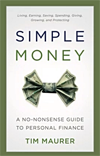 Director of Personal Finance
Tim Maurer has devoted much of his work to taking financial complexity and bringing it back to the basics. His latest work, the newly released
Simple Money, is a step-by-step guide that can be used as a real-life workbook to plan for today and for life, for the unexpected and for the inevitable.
Simple takes a no-nonsense look at living, earning, saving, spending, giving, growing and protecting.
In this Q&A, Tim talks about how the most important word behind any financial plan might be
why, and how his book can deliver the magical word of
hope.
|